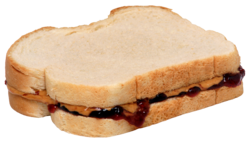Peanut butter sandwich

A peanut butter and jelly sandwich on white bread
|
|
| Alternative names | PB&J |
|---|---|
| Course | Lunch or snack |
| Place of origin | United States |
| Serving temperature | Room temperature |
| Variations | Peanut butter and jam, other nut butters, with butter or marshmallow fluff |
| 432 kcal/18 g fat/3 g fiber/59 g carbs kcal | |
| |
|
A peanut butter and jelly sandwich, or PB&J, popular in the United States, includes one or more layers of peanut butter and one or more layers of either jelly or jam on bread. Sometimes the sandwich is eaten open-faced or with one slice of bread folded over (effectively a "half sandwich"). The type of fruit preserve should balance the texture and sweetness of the peanut butter, while the bread should not overwhelm the filling. If the peanut butter is not spread on each slice of bread, the sandwich will become soggy.
Sometimes the sandwich is eaten without any jam or jelly, which is simply a peanut butter sandwich. Variations on the sandwich can be created by changing the jam or jelly to honey and instead of peanut butter, someone may use almond butter or another nut butter. Even spreads like cream cheese or chocolate spread can be used in place of the peanut butter. When marshmallow fluff is substituted for the jam or jelly, the sandwich becomes a fluffernutter.
A 2002 survey showed the average American will have eaten 1,500 of these sandwiches before high school graduation.
Peanut butter was originally paired with a diverse set of foods, such as pimento, nasturtium, cheese, celery, watercress, and toasted crackers. In a Good Housekeeping article published in May 1896, a recipe "urged homemakers to use a meat grinder to make peanut butter and spread the result on bread." The following month, the culinary magazine Table Talk published a "peanut butter sandwich recipe."
...
Wikipedia
